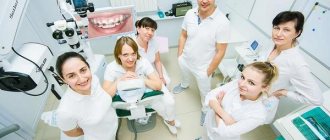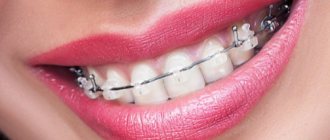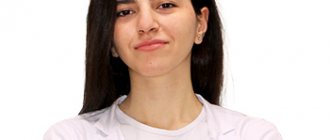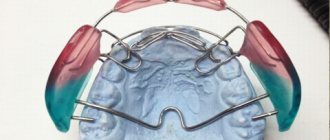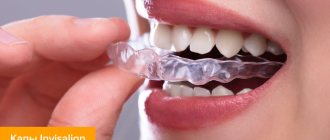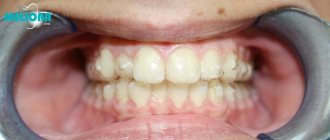A deep bite is a functional disorder in which the upper incisors overlap the lower ones by at least 1/3 of the crown surface when the dentitions are closed. The disease can cause teeth to become loose and fall out at a relatively early age.
What to do if a deep bite develops in adults? How to eliminate a functional disorder? You can get answers to these and other questions by carefully studying the article.
Types of occlusion defects and methods of their correction
Scientists have calculated that only 40% of the planet's inhabitants are the happy owners of an ideal bite. All others have deviations from the norm to one degree or another. Defects can be critical when they have a negative impact on human health, and practically unnoticeable, not leading to moral or physical discomfort.
The picture below shows occlusion anomalies:
Modern orthodontics includes several methods for correcting malocclusion:
- using braces;
- through surgery;
- using myotherapy (physical exercises) and non-braces corrective devices.
Why you need to straighten your teeth
Please note that the question is not whether it is worth correcting the bite - it simply needs to be done, and for several reasons:
- To avoid increased abrasion, caries, removal - when everything is normal, all incisors are evenly used when chewing, and in case of disturbances, some work more, others less; The former lose enamel faster and chip, the latter are less resistant to bacteria.
- To prevent diseases of the temporomandibular joints as a result of their mutual displacement. This pathology is also unpleasant due to bruxism, muscle spasms, clicking and crunching.
- To protect the gums, tongue and inner cheeks from injury caused by out-turned or tilted incisors.
- In order to grind food well during eating, not to create additional stress on the gastrointestinal tract and not to provoke problems with stool, enterocolitis, gastritis.
- To prevent problems with ENT organs and breathing, eliminate the source of bacterial accumulation and not give a single chance to sore throat, sinusitis, and otitis media.
People who have experienced complexes about their chin and then decided to have surgery or wear braces can tell a lot about whether to correct their bite. After medical help, they are much more willing to show their smile when communicating.
At what age should you start correcting your bite?
Dentists believe that occlusion correction can be carried out at any age using appropriate techniques. Thus, children are not treated with braces because their skeletal system is in active growth, and the bones, including the dentofacial apparatus, have not yet formed. Therefore, young children, before they have permanent teeth yet, are treated with myotherapy, plates and trainers. Note: such methods are used in the presence of non-critical developmental defects. Complex congenital pathologies that have a negative impact on the health or quality of life of the baby are treated surgically.
The optimal period of treatment with braces is from approximately 12 to 16 years. At older ages, the process takes longer.
Important: some dental anomalies can be corrected without the use of braces. The possibility of such treatment is determined by the doctor.
Basic methods of orthodontic treatment for adults:
- Treatment with fixed orthodontic equipment
- a brace system and additional orthodontic devices that can be installed on it if necessary. - Combined treatment.
In complex cases with significant skeletal disorders, orthodontic treatment alone is not enough to cure the patient. In these cases, it is necessary to work together with an orthognathic surgeon and an orthodontist, who will create a single treatment plan that combines brace treatment with jaw surgery. In most cases, at the beginning there is a preparatory orthodontic stage, then the operation is performed. After healing, another round of orthodontic treatment is often required to ensure that the contact between the teeth is as precise as possible in their new position. - Treatment with a system of aligners
- transparent silicone trays.
This is the only effective method of orthodontic treatment WITHOUT braces for adults, which, with some restrictions, can be a full replacement for them.
- Treatment with removable equipment
- plates and tray trainers for adults is ineffective, and orthodontists do not use them as an active device. But they are successfully used as retainers to maintain the results of orthodontic treatment.
Read more about each type of treatment in our articles:
- Correcting a bite without braces using mouth guards.
- How is braces treatment performed?
- What orthodontic devices do our orthodontists use to correct the bite?
Corrective exercises – myotherapy
As a rule, myotherapy is an addition to the correction of occlusion using various orthodontic devices or as the main method in the treatment of children from 4 to 8 years old. Physical exercises help develop and strengthen facial muscles, stimulate bone growth, and have a positive effect on trophic processes.
Let's look at some effective exercises:
- to correct a deep bite: stand straight with your chin raised as much as possible. Move the lower jaw forward, then return to its original position. Repeat 15 – 17 times;
- to correct open occlusion: take a pencil (you can put a rubber tube on it), squeeze it with your teeth with adequate force. Perform for 4 – 5 minutes;
- with a crossbite: open your mouth as wide as possible, move your jaw towards the defect, close your jaws in the correct position for 5 seconds, then relax, then repeat the exercise again;
- to correct mesial occlusion: use your tongue to press on the inside of the front part of the upper dentition. Perform the exercise for 5 minutes.
Important: when performing any exercises of the myogymnastics complex there should be no pain. After each approach, you need to let the muscles relax for 1 minute.
The absence of one or more teeth leads to malocclusion
If we see adult patients, then, as a rule, the malocclusion pathologies that we most often encounter are associated with the absence of one or more teeth for quite a long time.
Is it necessary to correct the bite in such cases? Yes! If this situation is not corrected immediately, the teeth begin to move. Even if everything was fine with a person, but for some reason a tooth was removed, the teeth begin to move towards the defect of the missing tooth both in the lower jaw and in the upper jaw. The Popov-Godon effect develops.
What bite problems occur in this case?
Interdental contacts are disrupted, contacts between the upper and lower teeth are disrupted. Plus, a person begins to chew more on one side, that is, different muscle activity results, and the situation in the TMJ joint also changes.
And we work with all this and involve related specialists.
Orthodontics must be carried out, that is, we must return the teeth to their previous position, restore the missing tooth with an implant, as a rule, and then at the very end, if the teeth are worn out, the patient is transferred to an orthopedist.
By the way, if we talk about an orthopedic dentist, then the bite can be perfectly corrected with crowns - especially in the height of the bite. But high-quality primary treatment must be provided by an orthodontist.
Records
Vestibular plates are removable orthodontic devices. This means that they can be removed for a while, for example, to eat or brush your teeth. The plate for correcting pathologies is made individually for each patient using personal casts of the jaws.
The base of the plate is a plastic base that is adjacent to the palate. Arcs, clasps and screws are integrated into it. The base color can be neutral or colored.
These devices are mainly used in childhood and adolescence, when the dental system is not yet fully formed and therefore the dental elements are able to move relatively easily under the influence of directed force. The plates are also used to correct pathologies in adult patients, but only in mild cases.
Diagnosis of anomalies
There are obvious cases, such as a pronounced diastema or torsion, you can notice them yourself when standing in front of a mirror. But there are also minor disorders that are no less dangerous to health, and only a specialized doctor can identify them.
Usually, hidden defects are easily recognized by a dentist - when he conducts a preventive examination, removes plaque or places a filling. Then he describes the problem and gives a referral to an orthodontist, who will determine how to straighten the jaw, bite, and a couple of adjacent teeth. To do this, a specialist will conduct a thorough examination of the patient’s mouth with a computed tomography or x-ray.
The anomaly can also occur during life, for example, after injury. Therefore, it makes sense to visit a doctor regularly, every six months, so that he either confirms that everything is in order, or promptly notices unwanted changes, which are easier to stop at the initial stage.
Trainers
Orthodontic trainers are removable silicone covers for the teeth. They are worn for several hours a day: at night and for 2–4 hours during the day. They are used to correct occlusion in children and in simple situations (for example, when there are gaps between dental elements) in adults.
There are several types of trainers:
- standard for the initial stage of treatment - made of soft pink silicone. This period lasts about six months. The main goal is to influence the position of the jaws and facial muscles;
- standard for the final stage - made from harder blue silicone. They directly influence the movement of teeth in the dental row;
- Lm-activators are trainers, the unique feature of which is that they can be used before all teeth erupt, when the process is just beginning. Their use allows the teeth to settle into place immediately after eruption;
- myobraises – allow for early correction in a natural way, from the age of 3 years. The system does not work on the consequence, but on the causes of the formation of malocclusion. Myobraises are worn for 1 hour during the day and worn throughout the night.
Causes of deformation
Reasons for the development of malocclusion:
- genetic factor;
- in childhood - improper attachment to the breast, bad habits in the form of finger sucking, pacifiers, too early removal or loss of milk teeth;
- inappropriate jaw and teeth sizes, for example, teeth that are too large relative to the size of the jaw;
- facial injuries or chronic diseases that provoke respiratory dysfunction;
- strong pressure from the jaw muscles, as a result of which the lower jaw shifts forward;
- deficiency of hormones produced in the thyroid gland.
Mouth guards
Mouthguards, or aligners, are removable plastic or silicone transparent covers on the teeth. Made individually for a specific patient. They are worn constantly and are removed only for eating and hygiene procedures.
They are practically invisible, so they do not cause moral discomfort. The therapeutic effect is determined by a soft force effect on the dental elements, causing them to move in a given direction. The main disadvantage is the inability to eliminate particularly complex defects.
Important: the effectiveness of mouth guards for correcting malocclusion depends not only on the severity of the clinical case, but also on strict self-discipline. Failure to comply with the orthodontist's instructions will negate all efforts made.
Braces severely injure mucous membranes
It is believed that orthodontic structures strongly rub the inner surface of the lips and cheeks, injure the tongue, and get in the way in the mouth. In fact, discomfort can only occur during the adaptation period. Orthodontic structures have an ergonomic shape; all their elements are rounded and do not have sharp corners to prevent injury to the mucous membranes. With high sensitivity, if discomfort still occurs, you can use special wax to cover the protruding parts of the structure.
Aligners we offer to patients
3 D Avantis is a domestic analogue of the world famous American system. In terms of quality and efficiency, it is in no way inferior to other aligners, but the cost of treatment and the production time for a set of aligners are noticeably reduced.
Star Smile is a product of a large Russian company. StarSmile aligners are manufactured using ultra-modern equipment. The use of unique UClear technology ensures the highest precision of products. Mouthguards move teeth within specified time frames and are effective against interdental spaces up to 6mm, deep bites, crossbites and crowded teeth.
Invisalign is the most famous American manufacturer of aligners. It was Invisalign that became the pioneers in this area and remains a leader to this day. Small disadvantages for Russian patients may be the long production time for a set of mouth guards, as well as the relatively high cost of the set.
